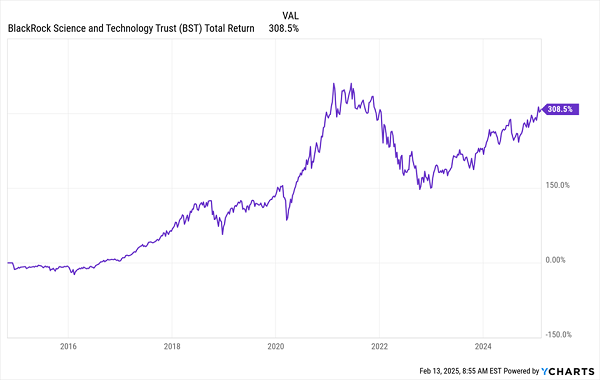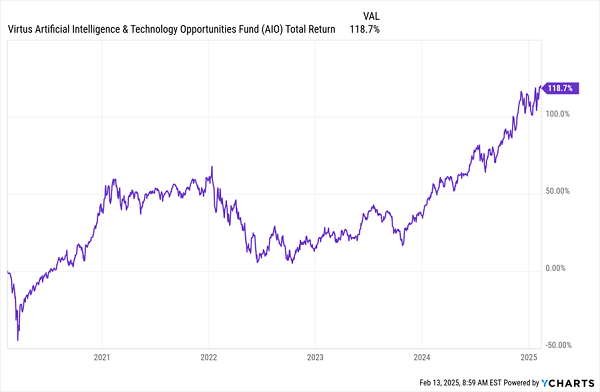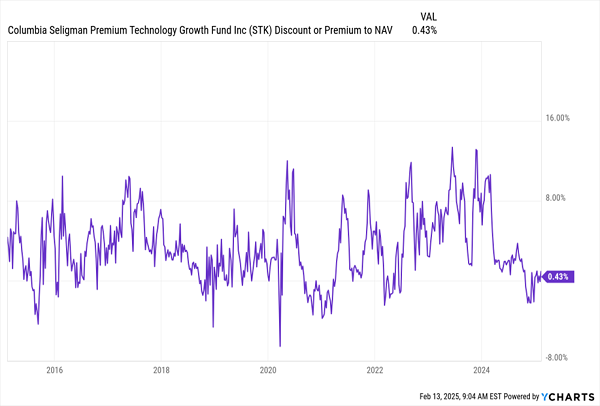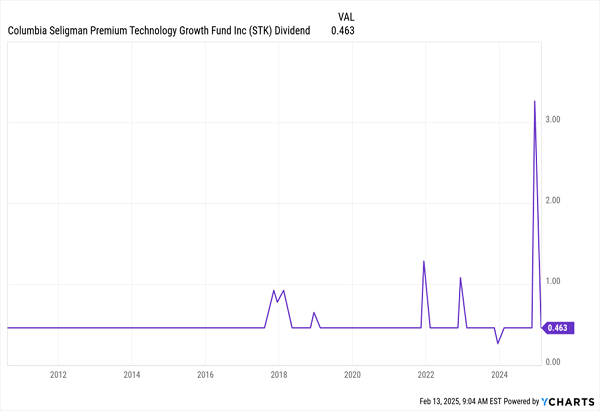If you’re like most income investors, you’re on the hunt for stocks and funds that can stand up to a storm these days.
So that’s what I’m going to give you below—in the form of three “all-weather” closed-end funds (CEFs) kicking out an outsized 6.8% average yield.
They’ve stood firm through every headwind imaginable—wars, pandemics, inflation, you name it—and have done nothing but profit over the long haul. Through all that, this trio has kicked out annualized total returns (with dividends reinvested) of 15%+ each.
“Shock-Proofing” Your Portfolio, Crushing ETFs
These funds’ stellar returns come from both the sector they focus on—tech—and smart management that’s kept all three going strong.
One thing I should mention is that these funds are not tech ETFs. We avoid those because tech can be volatile, and if you buy an ETF at the wrong time, you may have to wait a while for it to recover. And critically, because of tech ETFs’ lousy yields, you’ll have no income to collect while that happens.
That’s where tech-focused closed-end funds (CEFs) come in. They aim to “translate” profits from their holdings into huge dividend payouts. That means management takes a hands-on approach that helps these funds outperform while offering yields over 10 times bigger than what your average tech-focused index fund pays.
Let’s get into these three high-paying tech CEFs now.
Tech CEF #1: Big-Name Stocks From a Big-Name Manager
BlackRock is the world’s largest asset manager, with over $10 trillion in assets. It has all the connections and resources that come with that status. That’s helped the BlackRock Science and Technology Trust (BST) return over 308% (including dividends) since its IPO a little over a decade ago. (BST is a holding of my CEF Insider service.)
BST Delivers—Powered By Its Payout

BST’s portfolio is a who’s-who of Big Tech: Amazon.com (AMZN), Tesla (TSLA) and Microsoft (MSFT) all make the cut, while it also holds lesser-known firms like Cadence Design Systems (CDNS), which is crucial for semiconductor development.
BST also generates income by selling covered-call options on its portfolio. The beauty of this approach is that BST collects fees from investors in return for these options, and it keeps the cash no matter how these trades play out.
This strategy adds stability in volatile markets and helps BST fund its 7.8% dividend. As a result, investors get a high-yield play on tech with solid risk management and a long-term track record of outperformance.
Finally, the fund’s 4.3% discount to net asset value (NAV, or the value of its underlying portfolio) suggests more gains ahead. The discount to NAV is unique to CEFs and is just what it sounds like: an indicator that the fund trades below the value of its assets. BST has seen premiums as high as 2.8% in the last year.
Tech CEF #2: AI Without the AI Hype
The Virtus Artificial Intelligence & Technology Opportunities Fund (AIO) is another tech fund with a strong track record, more than doubling investors’ money in the four short (and turbulent!) years since its IPO, delivering 17.8% annualized gains, as of this writing.
Despite the name, AIO isn’t just an AI play—it’s a broad-based investment in disruptive tech that combines AI stocks like NVIDIA (NVDA), Microsoft and Amazon.com with less volatile but still disruptive firms. Those include Eli Lilly & Co. (LLY) and even JPMorgan Chase & Co. (JPM), which has used technology to dominate the wealth-management industry over the last couple of decades.
Unlike pure growth funds, AIO blends growth stocks with convertible securities, balancing upside potential with downside protection while ensuring its 7.3% dividend is reliable and well supported.
AIO’s approach has worked so well that it’s been quietly growing its dividend: The regular payout is up 38.5% in the last five years, with a couple of special dividends thrown in. That’s helped power its outsized 119% total return in that time.
AIO’s Strong Returns

AIO’s “hybrid” approach of using convertibles alongside stocks has attracted more investor attention in the last two years. That, in turn, has resulted in the fund trading above its portfolio value, with a 7.3% premium to NAV as I write this.
That makes AIO a bit riskier than BST, so it may make sense to slowly dip a toe into this fund. But it’s also worth noting that tech CEFs tend to get high premium pricings, with the aforementioned BST hitting a 12% premium a couple times over the last decade.
This suggests AIO could see an even bigger premium, especially if it keeps hiking payouts, which its strong returns suggest could happen in the near term.
Tech CEF #3: A “Hidden” 17% Yield
Finally, we’ve got the Columbia Seligman Premium Technology Growth Fund (STK), which has returned 18.6% annualized over the last decade, as of this writing, one of the best performances of any fund on the market.
That STK has delivered such strong profits for so long speaks volumes. It’s why the fund should trade at a huge premium (and usually does).
STK Goes on Sale

Fortunately, though, STK has seen its NAV soar so much that its premium market price has faded, meaning you can now buy it at around par. As you can see from the chart above, that’s a pretty rare occurrence historically, and it won’t last. This is why.
Big Special Dividends Bolster STK’s Regular Payout

STK’s “official” yield, based on its regular dividends, is relatively small, at just 5.6%. But the fund also has a history of special payouts that can bump up that yield considerably (the spikes and dip in the chart above). And at the end of last year, after STK earned a 78% return over 2023 and 2024, it gave investors a large slice of those profits in the form of a huge one-time cash dividend (the spike on the right side of the above chart).
That means that if we were to even out all the special payouts over the last decade, we’d see that STK shareholders actually got a 17% yield per year on average, based on their initial cost of buying the fund! No matter how you look at it, STK is an income machine—and an unloved one at that.
Urgent: 5 “Crash-Resistant” Monthly Payers (Yielding 10%) You Must Buy Now
These 3 funds are just the beginning. I’ve got 5 more “crash-resistant” CEFs waiting for you that pay even higher dividends—I’m talking 10% average payouts here—and they kick dividends your way every month, too.
I’ve got the 5 CEFs in this “10% Monthly Dividend Portfolio” pegged for double-digit upside in the year ahead. Some of these funds have quietly been growing their payouts for years.
These 5 stout monthly payers are cheap now, but that won’t last. Click here to get the details on all five of these 10%-yielding monthly payers, as well as a free Special Report revealing their names and tickers.
